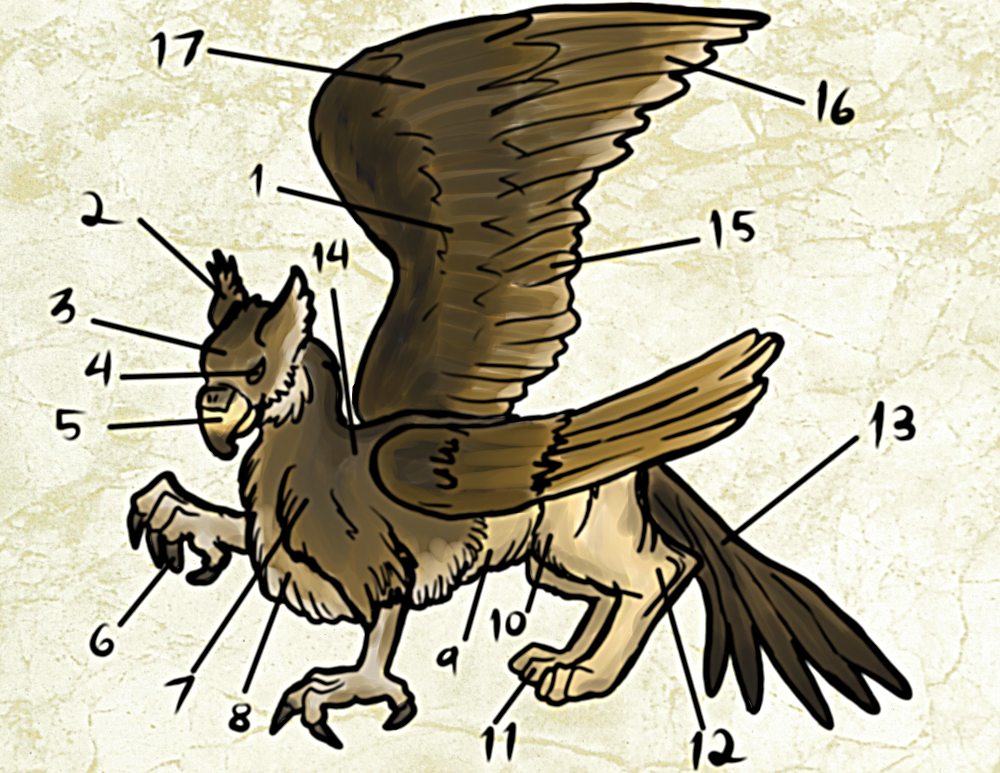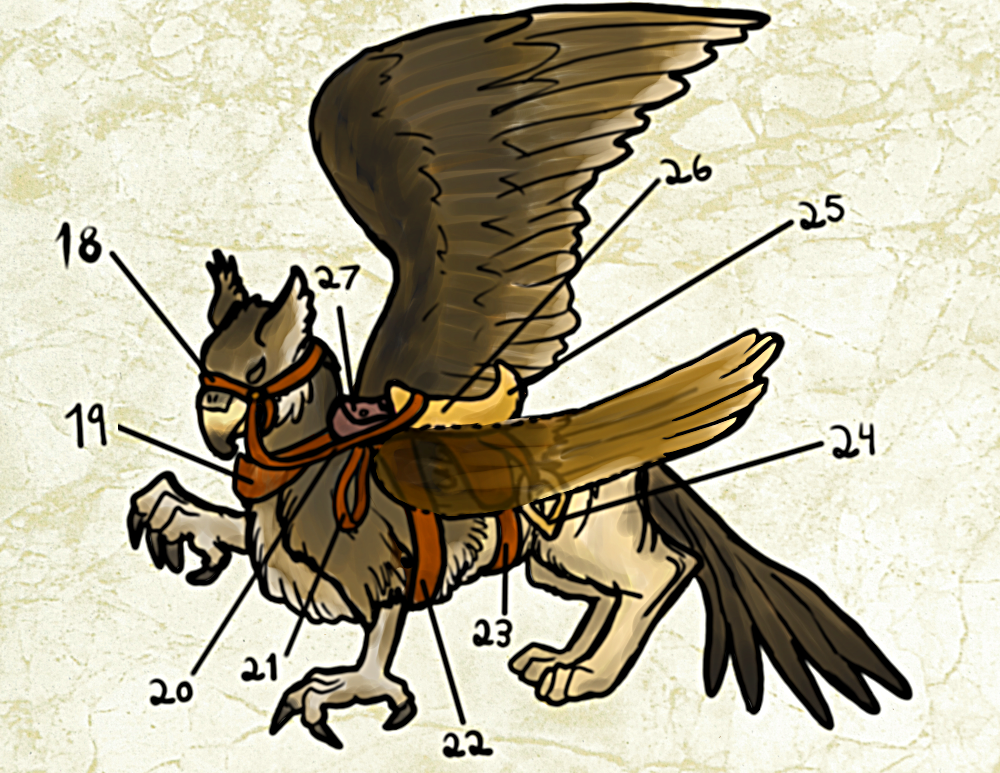How to tame a gryphon
and
what you need to know

1: Wing
2: Ear
3: Forehead
4: Eye
5: Beak
6: Talons
7: Shoulder
8: Chest
9: Flank
10: Stifle
11: Paws
12: Hock
13: Tail
14: Withers
15: Secondaries
16: Primaries
17: Coverlets
Basics about gryphons:
- The head and forelegs are of an eagle and the hind is of a lion, their tail feathered at the end.
- Gryphons can be temperamental. They are very intelligent, strong, and ferocious. Some of their characteristics include: playful, aggressive, sociable, quick changes in mood, witty, engages in favoritism, and, most importantly, prideful.
- Used as war mounts during times of war and couriers during times of peace. They’re employed as guards of Griffinrock and all of Tarith.
- In Griffinrock, gryphons are fed mostly fish. While on patrol, they may eat whatever meat and vegetables are available but are typically given substituted dry meat pellets. They’ll eat whatever livestock you can find and hunt, including: fish, lamb, sheep, horse, bear, boar, deer, elk. They are particularly found of squash.
- Taxpayers may send meat for gryphons in exchange for paying less taxes.
- Gryphons are able to carry the heaviest and biggest male whilst hauling cargo, lifting anywhere between 1 – 2 tons.
- They’re the size of a horse, but as heavy as a moose.
- Females are bigger than males, with various brown or beige patterns on their feathers. Males are dark brown or black, with no pattern, and are faster and more playful. As females can be more temperamental, males are better for taming your first time. Rarely, both sexes can be born as near-white.
Luring and taming:
The trick to taming wild gryphons is to stay calm, be non-threatening, and be their friend, although some gryphon-riders choose to take a more aggressive approach. You can choose to tame babies or adults, but adults are harder to tame as they’re not as playful.
In my experience, training a baby gryphon with persuasion and positive reinforcement, with mild use of scolding and consequential punishments, is the best approach to a well-rounded gryphon. This instills trust between you and your gryphon whilst also showing your dominance: that you are his or her “alpha”.
- The first step to taming is to lure a baby gryphon out of the nest with their favorite food and charm. For many gryphons, favorite foods are venison mixed with pumpkin. Lure the baby away from the nest, far enough away so that the parents aren’t able to interrupt. Be inviting and playful.
- The second step is to tie a rope around them whilst they’re distracted by your play, preferably the neck, chest, or foreleg. Never tie a rope around a gryphon’s wings, for you will damage them.
- The third step is to slowly guide them all the way back to the Aerie training ground and let them sleep in an ready-made nest as soon as you’re there; use a sleeping vial if they are taking a while to fall asleep, as they may be overstimulated.
- The fourth step is to wait by the nest until they wake up, then feed them again. Be extremely friendly and playful. It is imperative to create a strong bond in order to have a hassle-free experience later. Befriending your gryphon will ensure absolute loyalty from them. Spend the first week or two getting to know your gryphon and learning their personality and characteristics. Try to understand them, as they will grow to rely on you.
- The fifth step, using positive reinforcement, train them to: stop, come, sit, lie down, launch, dive, swoop, turn, perch, stay grounded, leave it, take it, and kill. Train flight and attack maneuvers last, to avoid endangering yourself or others. You can choose to use verbal commands, cues with a crop or stick, hand and leg cues, or a mix of all techniques (which I’d recommend).
Training tips:
Training will take time, but it is important to train your gryphon in all their commands before adulthood for best results. Gryphons grow fast but also learn fast: it only takes six to seven months for a gryphon to reach adult size but about a year for your gryphon to reach sexual maturity. It takes the females longer to grow than the males. Ages 1-6 months is the most sociable period. By the time a gryphon becomes a yearling, they can be challenging to handle, due to their playful and prideful characters. Dominance behaviors in males can also arise while in the presence of females. This again is another reason to learn your gryphon’s personality so that you can combat this with the right methods and approach.
Be aware that training a gryphon is the easy part: gryphons live for 80 to 100 years, just like humans, and just like humans they can change with the times; their moods and characteristics, will and attitudes can all change. They’re at their physical peak between twelve months and fifty years old and thus usually used as couriers in their older years.
Some gryphons are untamable, and it’s important to be aware of the warning signs which include: extreme aggression, constantly trying to escape, attempts to harm another gryphon, and a general disconnect from you and people.
Never look up at an untamed gryphon, they will immediately think you are a threat and charge you.

18: Bridle
19: Breast Collar
20: Reins
21: Dive Strap
22: Girth
23: Cinch
24: Stirrup
25: Cantle (Saddle)
26: Seat (Saddle)
27: Saddlebag
How to ride a gryphon:
- When on the ground, riding a gryphon is very similar to riding a horse: feet in the stirrups, knees bent, posting the trot, back arched over for the canter or the gallop, sitting deep to make them slow.
- When preparing to fly, arch yourself forward and go into a canter to lift off. Ensure your legs are relaxed and your back remains arched.
- Once in the air, stay flush with the gryphon’s back to avoid wind resistance and to avoid connecting with your gryphon’s wings. Once at a slow, steady pace in the sky, you can sit up and relax.
- Sitting up can be tricky when flying fast, but you must also learn to master sitting up in between the flaps of your gryphons wings; this is essential for combat and wielding weapons like bows whilst flying. Learn the rhythm of your gryphon’s wings.
